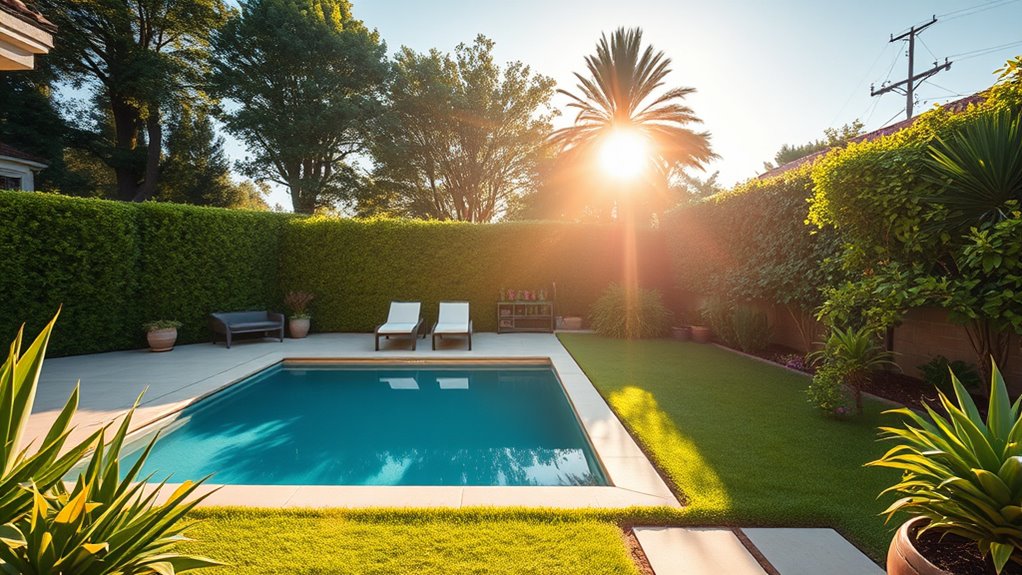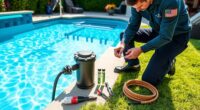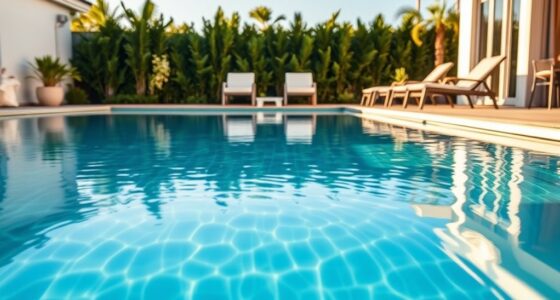To find the best spot for your endless pool, choose a flat, level area that can support its weight and is close to your main living space for convenience. Make sure it gets enough sunlight or shade, and has good drainage to prevent water buildup. Avoid windy, shaded, or noisy locations, as well as areas near trees that shed debris. Keep these tips in mind to create a relaxing, low-maintenance pool area—more helpful insights await you.
Key Takeaways
- Choose a flat, level area with sufficient support to handle the pool’s weight.
- Position near main living spaces for easy access and convenience.
- Avoid windy locations like open fields or rooftops that cause water disturbance.
- Stay away from shaded spots prone to algae growth or debris from trees.
- Ensure good drainage and adequate ventilation to prevent humidity buildup and water issues.
Ideal Locations for Installing Your Endless Pool
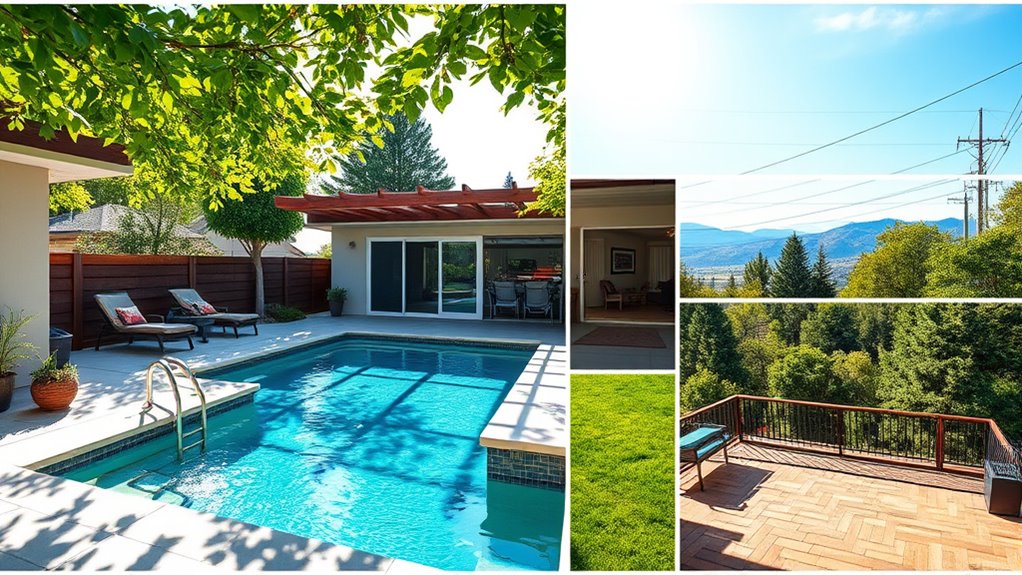
Choosing the right location for your Endless Pool is essential to maximize its benefits and guarantee easy access. You want a spot that offers convenience, privacy, and proper ventilation. Look for a flat, level surface that can support the pool’s weight and provides enough space for safe entry and exit. Consider placing it near your home’s main living areas for quick access and to enjoy the surroundings. Make certain there’s sufficient sunlight or shade, depending on your preferences, and avoid areas prone to strong winds or excessive noise. Good drainage is also critical to prevent water accumulation around the pool. Finally, think about the view and ambiance, creating a relaxing environment that encourages regular use. Proper placement enhances your pool experience and maintains your property’s aesthetic. Incorporating space and organization strategies can help you assess and optimize your yard layout for a seamless integration of your pool.
Spots to Avoid When Setting Up Your Endless Pool
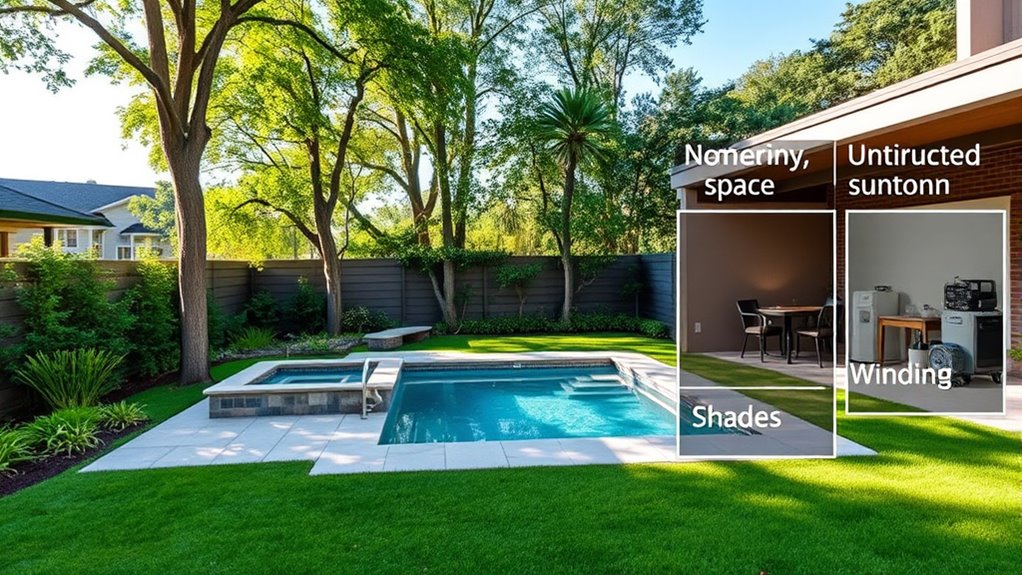
Avoid placing your Endless Pool in areas prone to strong winds, as this can cause water disturbance and make maintenance more difficult. Wind can create ripples and splashes, affecting the pool’s stability and cleanliness. Stay away from open fields or rooftops exposed to gusts, which can also increase evaporation and energy costs. Avoid installing your pool near trees or heavy foliage that shed leaves or debris, as this can clog filters and require frequent cleaning. Similarly, steer clear of shaded areas with poor sunlight, which can promote algae growth. Don’t place it close to noisy or disruptive locations like busy roads, as vibrations and pollution can impact your experience. Choosing a calm, protected spot ensures easier upkeep and a more enjoyable swimming environment. Additionally, selecting a location with proper ventilation can help prevent humidity buildup and maintain the pool’s structural integrity.
Frequently Asked Questions
Can I Install an Endless Pool Indoors Without Ventilation?
You shouldn’t install an endless pool indoors without proper ventilation. Without adequate airflow, humidity levels will rise, leading to mold, mildew, and structural damage over time. Ventilation helps control moisture and prevents musty odors. You need an exhaust fan or a dehumidifier to maintain a healthy environment. Make certain your indoor space is well-ventilated before installing the pool to avoid future issues and keep your space safe and comfortable.
What Are the Legal Restrictions for Installing Pools in Certain Areas?
Think of your property as a canvas and local regulations as the artist’s brushstrokes. You must follow zoning laws, building codes, and permits that vary by area. Some places have strict restrictions on pool placement, fencing, or safety features, while others are more relaxed. Check with your local authorities before installing to avoid legal strokes that could delay or halt your project. Being compliant guarantees your pool becomes a harmonious part of your landscape.
How Does Sunlight Exposure Affect Pool Maintenance and Longevity?
Sunlight exposure impacts your pool’s maintenance and longevity markedly. Direct sunlight speeds up algae growth and increases water evaporation, so you’ll need to balance sun exposure with shading or covers. UV rays can also degrade pool materials over time. To keep your pool in top shape, regularly clean, chemically treat the water, and consider installing shade structures or using pool covers, especially if your pool gets intense or prolonged sunlight.
Are There Specific Permits Required for Outdoor Pool Installation?
You’ll need to check local regulations before installing your outdoor pool. Think of permits like a map guiding your project—skipping them can lead to costly detours. Many areas require building permits, zoning approvals, or health department clearances. For example, a friend in Florida had to secure permits to comply with safety standards. Contact your city or county government early to make certain you follow all rules and avoid delays or fines.
What Safety Measures Are Recommended for Outdoor Pool Setups?
You should install safety features like a sturdy fence with a self-latching gate around your outdoor pool to prevent accidental falls. Keep pool covers when not in use, and install alarms on doors leading to the area. Regularly maintain the pool and ensure proper lighting for nighttime safety. Always supervise children and never leave the pool unattended to prevent accidents. These measures keep your outdoor pool safe and secure.
Conclusion
Choosing the right spot for your endless pool makes all the difference—place it where you can relax and enjoy, not where noise or harsh weather disrupts your peace. While an ideal location offers tranquility and convenience, avoiding noisy, exposed, or cramped spaces prevents frustration. Think of your pool as a sanctuary; pick a spot that invites you in, not pushes you away. Your perfect pool environment transforms everyday exercise into a true retreat.

